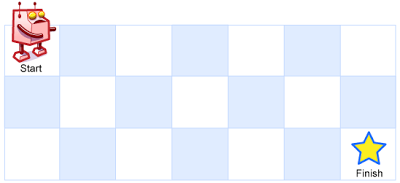题目:
A robot is located at the top-left corner of a m x n grid (marked 'Start' in the diagram below).
The robot can only move either down or right at any point in time. The robot is trying to reach the bottom-right corner of the grid (marked 'Finish' in the diagram below).
How many possible unique paths are there?

Above is a 7 x 3 grid. How many possible unique paths are there?
Note: m and n will be at most 100.
Example 1:
Input: m = 3, n = 2 Output: 3 Explanation: From the top-left corner, there are a total of 3 ways to reach the bottom-right corner: 1. Right -> Right -> Down 2. Right -> Down -> Right 3. Down -> Right -> Right
Example 2:
Input: m = 7, n = 3 Output: 28
分析:
简单说就是给一个m*n的网格,从左上角走到右下角,只能往下前进一格或往右前进一格,共有多少种走法。
到(m,n)格的路径数等于到(m-1,n)的路径数加上(m,n-1)的路径数,根据这个我们可以通过递推求得结果,机器人初始的位置路径数等于1,注意边界条件的判定,也可以将二维数组多开辟一行一列,用来跳过边界条件的处理,还可以先将第一行和第一列都初始化为1,再进行递推求解。
此外我们还可以通过递归求解此问题,即uniquePaths[m][n] = uniquePaths(m-1, n) + uniquePaths(m, n-1),只不过我们不是从起点求到终点,而是最先求右下角的路径数通过递归求解,同样也要注意递归终止条件。
程序:
C++
//Solution 1 class Solution { public: int uniquePaths(int m, int n) { vector<vector<int>> res(m+1, vector<int>(n+1, 0)); for(int i = 1; i < m+1; ++i){ for(int j = 1; j < n+1; ++j){ if(i == 1 && j == 1) res[1][1] = 1; else res[i][j] = res[i-1][j] + res[i][j-1]; } } return res[m][n]; } }; //Solution 2 class Solution { public: int uniquePaths(int m, int n) { if(m < 0 || n < 0) return 0; if(m == 1 && n == 1) return 1; if(res[m][n] > 0) return res[m][n]; res[m][n] = uniquePaths(m-1, n) + uniquePaths(m, n-1); return res[m][n]; } private: int res[101][101]={0}; };
Java
class Solution { public int uniquePaths(int m, int n) { int[][] res = new int[m+1][n+1]; for(int i = 1; i < m+1; ++i) for(int j = 1; j < n+1; ++j){ if(i == 1 && j == 1){ res[1][1] = 1; } else{ res[i][j] = res[i-1][j] + res[i][j-1]; } } return res[m][n]; } } class Solution { private int[][] res = new int[101][101]; public int uniquePaths(int m, int n) { //int[][] res = new int[m+1][n+1]; if(m < 0 || n < 0) return 0; if(m == 1 && n == 1) return 1; if(res[m][n] > 0) return res[m][n]; res[m][n] = uniquePaths(m-1, n) + uniquePaths(m, n-1); return res[m][n]; } }